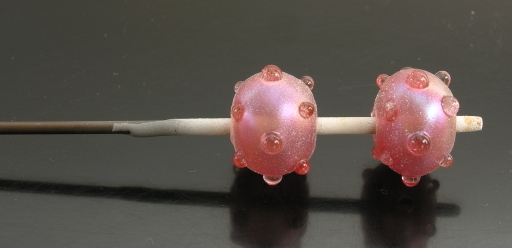One of the things that people find kind of odd about my working technique (yeah, besides the fact that I work to the flame at a 45 degree angle) is that I tend to put my beads at the extreme tip of the mandrel. Now why would somebody be boneheaded enough to do that? After all, what happens if your glass glops over and covers the end, rendering your bead a rather useless end-cap?

double pixies, about 10x13mm each, on one mandrel. 1/16” diameter, 9” long, krag mudd release, odd lot lauscha pink soda lime glass, red hilite pixie dust. Made may08.
Well, I got into this habit while working with pixie dust and thompson enamels, becase I roll the beads in these particulates[1] , and the closer they are to the end of the mandrel, the less it interferes with the sides of the container (e.g. mini-muffin tins). This is also the reason I typically put only one abstract or pixie on a mandrel: because I can't roll the second bead very effectively.
Except, obviously, sometimes I can, as here.
This is the first time I can ever recall doing this, and they're pretty close in size and shape, so, yay me. It certainly helps that the beads are small, perhaps 10mm hole to hole. Also, that I've gotten better at putting on pixie dust and then heating it enough to cook on there, harder,[2] in my opinion, than just getting it while the bead's hot enough for it to stick in the first place. This dodge makes coating the second bead a little more realistic. However, it's still really much easier just to do one at a time, but I guess I just couldn't stand to waste a whole inch of unused bead release...
file created 14may08.
[1]Which is why these beads look so messy at full magnification—the loose pixie dust hasn't gotten washed off yet.
[2]Note the rainbow effect of the pixie dust: this comes from differentially heating it, and is right on the edge of burning it—it's taken me years, but I do have an internal time and temperature indicator in my head that [usually] tells me when the hilite pixie is about to burn into grey scum. Handy.
Unless otherwise noted, text, image and objects depicted therein copyright 1996--present sylvus tarn.
Sylvus Tarn